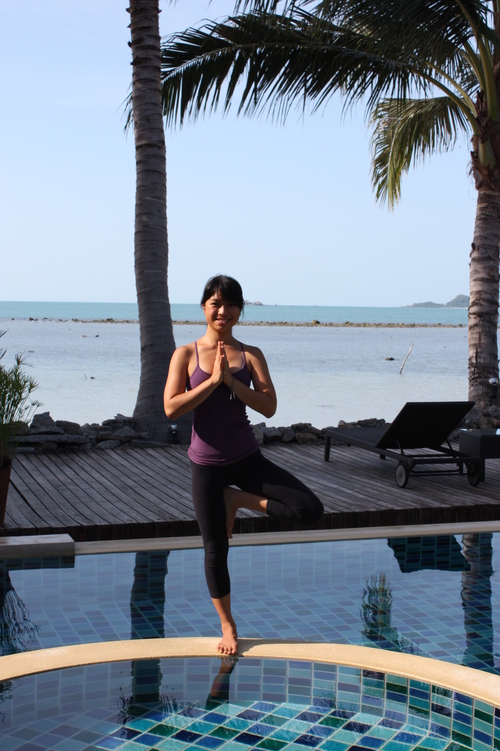Approximately 9 years ago, I stepped into my very first Ashtanga class. Nine years later today, I am still practicing in this lineage, albeit with a different purpose and concept.
I used to be competitive, a perfectionist, and still am, although I have since let that part of me gradually subside in the past 3 years or so, and along that, my image of a “perfect” Ashtanga practice.
I found yoga through my curiosity. I was young, fit, and flexible. I gained strength and flexibility relatively fast that one of my first teachers recommended that I attend an Ashtanga class to feed my exploration of yoga asanas. I started out with led Ashtanga half-primary series about twice a week, then four times a week, and soon graduated to attending afternoon Mysore classes. I was hooked and onto something. I felt so alive after every class. Never did I thought I’d be the one religiously practicing the sequence 6 days a week, excluding moon days and ladies’ holidays, at 6am every morning. But it took me just another few months to become part of the Ashtanga “cult.” I was a complete fanatic, and prioritized my practice over anything else. In a way, you can say yoga ruined my life.
I was on the fast-track into the Intermediate Series. My pride and ego inflated, and along with it came my injuries. From hamstrings attachment (the “yoga butt”..link) and wrist pain, to knees and SI joint, to low back, then back to hamstrings, you name it. I’ve probably gone through all the common yoga injuries you can think of. And yet, I persevered in my practice with little modifications. Heat was building up in my body, my skin started breaking out, I was anxious and angry at little things. Although I always felt rejuvenated and strong after my daily practice, I’d become tired and sore later during the day. Going on a hike in the afternoon after I burnt myself up within 2 hours in the morning was always out of the question.
Until one day I realized, it’s not supposed to be like this. My asana practice should give me strength and vitality all day, not just an hour afterwards.
I started to question the incentive of my practice: Was I doing it just to show-off? Was I practicing for the sake of “looking good?” What exactly am I gaining by being able to get both legs over my head, and in exchange, hurting my back and neck?
I also started to panic: What would my teachers say? Would they think I just got lazy? Would I not be considered an Ashtangi any longer? This 6-day-a-week strong practice, it was rooted in lineage and research, was it not?
I have allowed Ashtanga to become such a big part of my identity that it was almost unbearable to think of it actually doing more harm than good to me. I have fallen into the trap of attaching my identity to the fruits of the practice, the exact opposite of what Patanjali said to do: abhyasa-vairagya-abhyam tan-nirodhah (The state of yoga is attained by persistent practice without attachment.)
“Falling off the Ashtanga bandwagon” actually didn’t happen by choice. I just started teaching more. And with that I naturally had to make some sacrifices in terms of my schedule and energy. At first I was a little upset that I couldn’t squeeze in the entire Primary series or the entire Intermediate series everyday, but then I came to accept it.
I started feeling like a “normal” person. I started sleeping-in on days I didn’t have to teach early in the morning and not feeling guilty about it. I picked up running and walking more. I can do my asana practice in the morning and still have energy to go hiking or kayaking or play volleyball in the afternoon.
Nowadays, my practice each week looks like this: 1-2 longer sessions (and by “long,” I mean at most 2 hours–no more 2.5 hours!) and 3-4 shorter sessions. I might not be “progressing” the asanas as quickly as I used to, and probably not as strong as I used to be, but who cares? I don’t think I’m gonna become enlightened by being able to do an arm-balance with one leg behind my head. Instead, I focus on how steady my practice is nowadays, and how I have a purpose for each practice rather than the mindset of I-just-have-to-do-it-because-I’m-an-Ashtangi. I use props (yes, what a horror as an Ashtangi) on days I feel like I need the extra nurturing, and on some days, my practice becomes more of a restorative one after a few sun salutations.

The purpose for the practice is to feel good, and not feel I-am-so-drained-from-yoga-that-I-can’t-do-anything-else-for-the-day (of course, the same goes for any other types of activities, whether physical or mental). The practice is supposed to help us juggle the stressors in our daily lives, and not add stress to it. As I slowly realized over the course of the past two years, part of the practice is finding balance.
What is your purpose of yoga?
















